Effect of Caste System on Educational System in India
VerifiedAdded on 2023/05/26
|13
|4984
|225
AI Summary
This article discusses the impact of the caste system on education in India. It highlights how the system has affected the growth and development of millions of lower caste students. It also explores the history of the caste system and its effects on the Indian society.
Contribute Materials
Your contribution can guide someone’s learning journey. Share your
documents today.
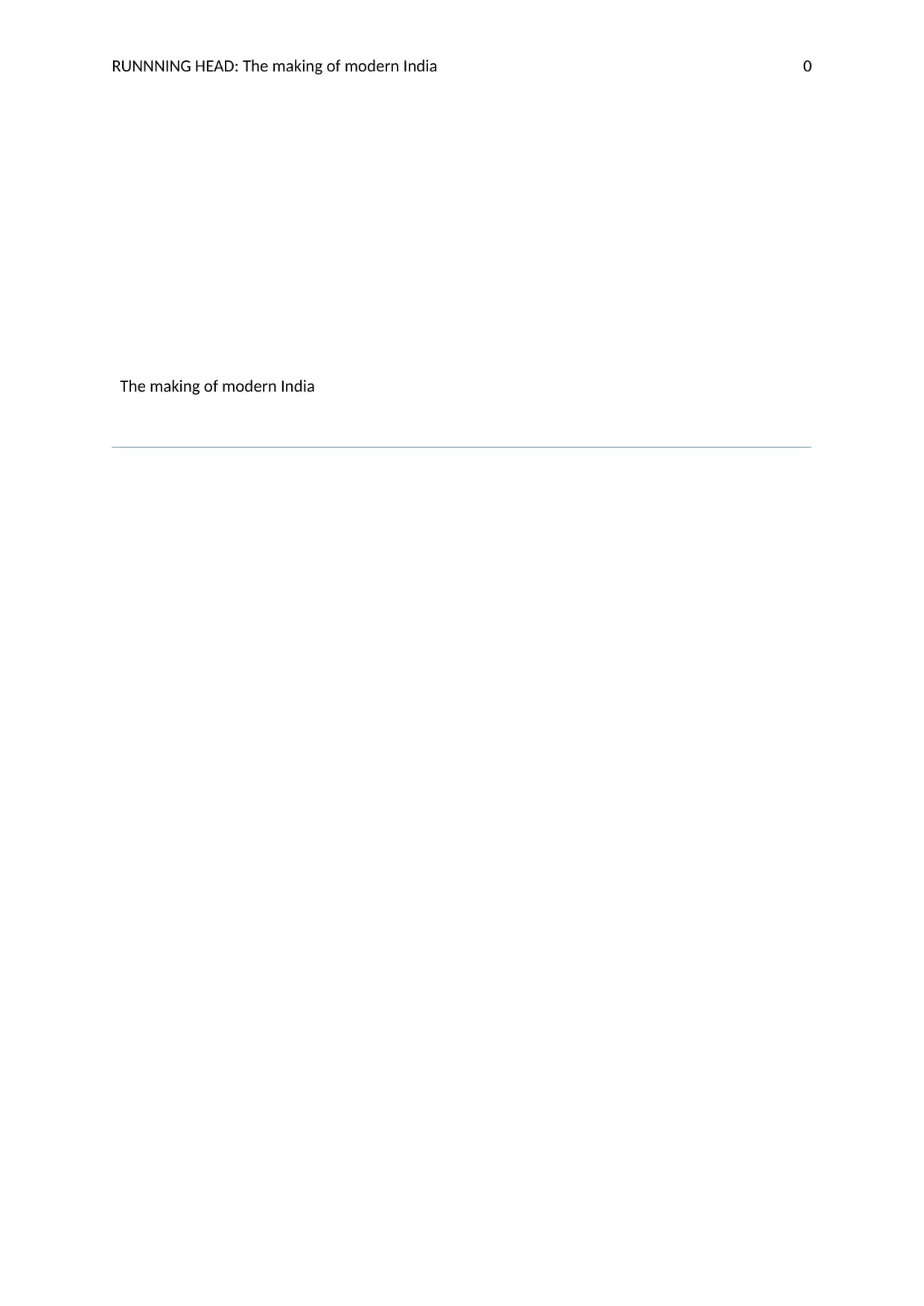
RUNNNING HEAD: The making of modern India 0
The making of modern India
The making of modern India
Secure Best Marks with AI Grader
Need help grading? Try our AI Grader for instant feedback on your assignments.
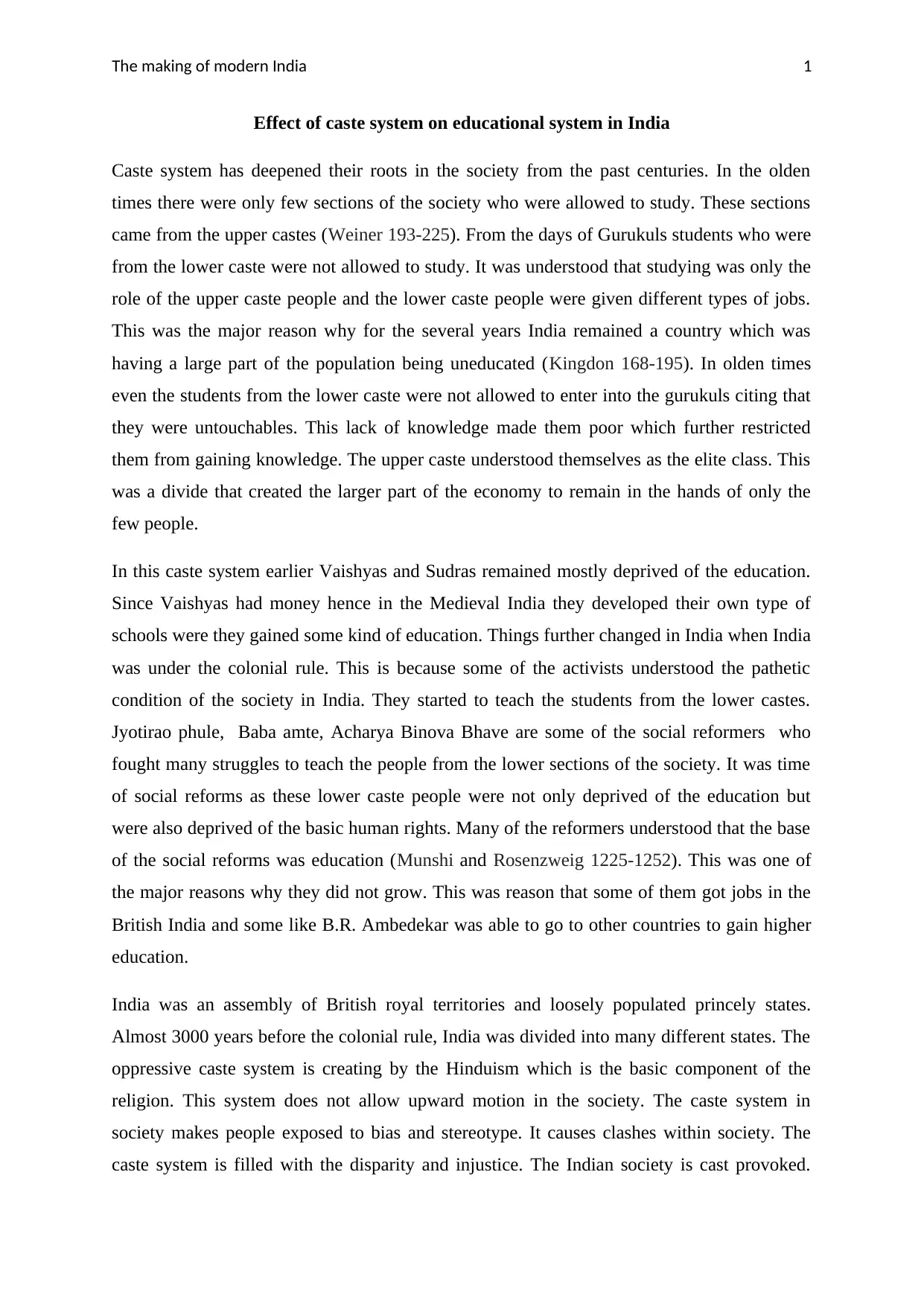
The making of modern India 1
Effect of caste system on educational system in India
Caste system has deepened their roots in the society from the past centuries. In the olden
times there were only few sections of the society who were allowed to study. These sections
came from the upper castes (Weiner 193-225). From the days of Gurukuls students who were
from the lower caste were not allowed to study. It was understood that studying was only the
role of the upper caste people and the lower caste people were given different types of jobs.
This was the major reason why for the several years India remained a country which was
having a large part of the population being uneducated (Kingdon 168-195). In olden times
even the students from the lower caste were not allowed to enter into the gurukuls citing that
they were untouchables. This lack of knowledge made them poor which further restricted
them from gaining knowledge. The upper caste understood themselves as the elite class. This
was a divide that created the larger part of the economy to remain in the hands of only the
few people.
In this caste system earlier Vaishyas and Sudras remained mostly deprived of the education.
Since Vaishyas had money hence in the Medieval India they developed their own type of
schools were they gained some kind of education. Things further changed in India when India
was under the colonial rule. This is because some of the activists understood the pathetic
condition of the society in India. They started to teach the students from the lower castes.
Jyotirao phule, Baba amte, Acharya Binova Bhave are some of the social reformers who
fought many struggles to teach the people from the lower sections of the society. It was time
of social reforms as these lower caste people were not only deprived of the education but
were also deprived of the basic human rights. Many of the reformers understood that the base
of the social reforms was education (Munshi and Rosenzweig 1225-1252). This was one of
the major reasons why they did not grow. This was reason that some of them got jobs in the
British India and some like B.R. Ambedekar was able to go to other countries to gain higher
education.
India was an assembly of British royal territories and loosely populated princely states.
Almost 3000 years before the colonial rule, India was divided into many different states. The
oppressive caste system is creating by the Hinduism which is the basic component of the
religion. This system does not allow upward motion in the society. The caste system in
society makes people exposed to bias and stereotype. It causes clashes within society. The
caste system is filled with the disparity and injustice. The Indian society is cast provoked.
Effect of caste system on educational system in India
Caste system has deepened their roots in the society from the past centuries. In the olden
times there were only few sections of the society who were allowed to study. These sections
came from the upper castes (Weiner 193-225). From the days of Gurukuls students who were
from the lower caste were not allowed to study. It was understood that studying was only the
role of the upper caste people and the lower caste people were given different types of jobs.
This was the major reason why for the several years India remained a country which was
having a large part of the population being uneducated (Kingdon 168-195). In olden times
even the students from the lower caste were not allowed to enter into the gurukuls citing that
they were untouchables. This lack of knowledge made them poor which further restricted
them from gaining knowledge. The upper caste understood themselves as the elite class. This
was a divide that created the larger part of the economy to remain in the hands of only the
few people.
In this caste system earlier Vaishyas and Sudras remained mostly deprived of the education.
Since Vaishyas had money hence in the Medieval India they developed their own type of
schools were they gained some kind of education. Things further changed in India when India
was under the colonial rule. This is because some of the activists understood the pathetic
condition of the society in India. They started to teach the students from the lower castes.
Jyotirao phule, Baba amte, Acharya Binova Bhave are some of the social reformers who
fought many struggles to teach the people from the lower sections of the society. It was time
of social reforms as these lower caste people were not only deprived of the education but
were also deprived of the basic human rights. Many of the reformers understood that the base
of the social reforms was education (Munshi and Rosenzweig 1225-1252). This was one of
the major reasons why they did not grow. This was reason that some of them got jobs in the
British India and some like B.R. Ambedekar was able to go to other countries to gain higher
education.
India was an assembly of British royal territories and loosely populated princely states.
Almost 3000 years before the colonial rule, India was divided into many different states. The
oppressive caste system is creating by the Hinduism which is the basic component of the
religion. This system does not allow upward motion in the society. The caste system in
society makes people exposed to bias and stereotype. It causes clashes within society. The
caste system is filled with the disparity and injustice. The Indian society is cast provoked.
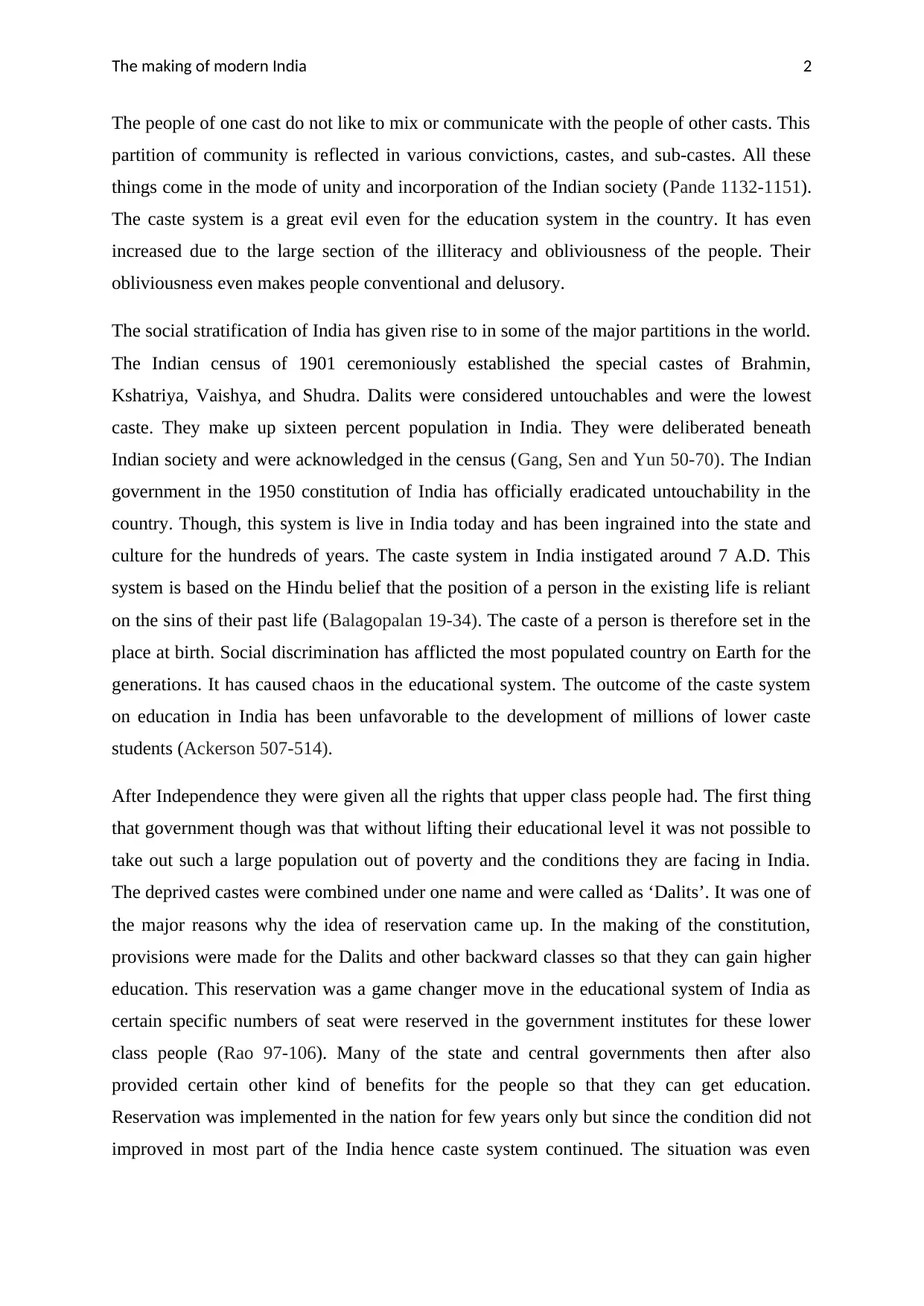
The making of modern India 2
The people of one cast do not like to mix or communicate with the people of other casts. This
partition of community is reflected in various convictions, castes, and sub-castes. All these
things come in the mode of unity and incorporation of the Indian society (Pande 1132-1151).
The caste system is a great evil even for the education system in the country. It has even
increased due to the large section of the illiteracy and obliviousness of the people. Their
obliviousness even makes people conventional and delusory.
The social stratification of India has given rise to in some of the major partitions in the world.
The Indian census of 1901 ceremoniously established the special castes of Brahmin,
Kshatriya, Vaishya, and Shudra. Dalits were considered untouchables and were the lowest
caste. They make up sixteen percent population in India. They were deliberated beneath
Indian society and were acknowledged in the census (Gang, Sen and Yun 50-70). The Indian
government in the 1950 constitution of India has officially eradicated untouchability in the
country. Though, this system is live in India today and has been ingrained into the state and
culture for the hundreds of years. The caste system in India instigated around 7 A.D. This
system is based on the Hindu belief that the position of a person in the existing life is reliant
on the sins of their past life (Balagopalan 19-34). The caste of a person is therefore set in the
place at birth. Social discrimination has afflicted the most populated country on Earth for the
generations. It has caused chaos in the educational system. The outcome of the caste system
on education in India has been unfavorable to the development of millions of lower caste
students (Ackerson 507-514).
After Independence they were given all the rights that upper class people had. The first thing
that government though was that without lifting their educational level it was not possible to
take out such a large population out of poverty and the conditions they are facing in India.
The deprived castes were combined under one name and were called as ‘Dalits’. It was one of
the major reasons why the idea of reservation came up. In the making of the constitution,
provisions were made for the Dalits and other backward classes so that they can gain higher
education. This reservation was a game changer move in the educational system of India as
certain specific numbers of seat were reserved in the government institutes for these lower
class people (Rao 97-106). Many of the state and central governments then after also
provided certain other kind of benefits for the people so that they can get education.
Reservation was implemented in the nation for few years only but since the condition did not
improved in most part of the India hence caste system continued. The situation was even
The people of one cast do not like to mix or communicate with the people of other casts. This
partition of community is reflected in various convictions, castes, and sub-castes. All these
things come in the mode of unity and incorporation of the Indian society (Pande 1132-1151).
The caste system is a great evil even for the education system in the country. It has even
increased due to the large section of the illiteracy and obliviousness of the people. Their
obliviousness even makes people conventional and delusory.
The social stratification of India has given rise to in some of the major partitions in the world.
The Indian census of 1901 ceremoniously established the special castes of Brahmin,
Kshatriya, Vaishya, and Shudra. Dalits were considered untouchables and were the lowest
caste. They make up sixteen percent population in India. They were deliberated beneath
Indian society and were acknowledged in the census (Gang, Sen and Yun 50-70). The Indian
government in the 1950 constitution of India has officially eradicated untouchability in the
country. Though, this system is live in India today and has been ingrained into the state and
culture for the hundreds of years. The caste system in India instigated around 7 A.D. This
system is based on the Hindu belief that the position of a person in the existing life is reliant
on the sins of their past life (Balagopalan 19-34). The caste of a person is therefore set in the
place at birth. Social discrimination has afflicted the most populated country on Earth for the
generations. It has caused chaos in the educational system. The outcome of the caste system
on education in India has been unfavorable to the development of millions of lower caste
students (Ackerson 507-514).
After Independence they were given all the rights that upper class people had. The first thing
that government though was that without lifting their educational level it was not possible to
take out such a large population out of poverty and the conditions they are facing in India.
The deprived castes were combined under one name and were called as ‘Dalits’. It was one of
the major reasons why the idea of reservation came up. In the making of the constitution,
provisions were made for the Dalits and other backward classes so that they can gain higher
education. This reservation was a game changer move in the educational system of India as
certain specific numbers of seat were reserved in the government institutes for these lower
class people (Rao 97-106). Many of the state and central governments then after also
provided certain other kind of benefits for the people so that they can get education.
Reservation was implemented in the nation for few years only but since the condition did not
improved in most part of the India hence caste system continued. The situation was even
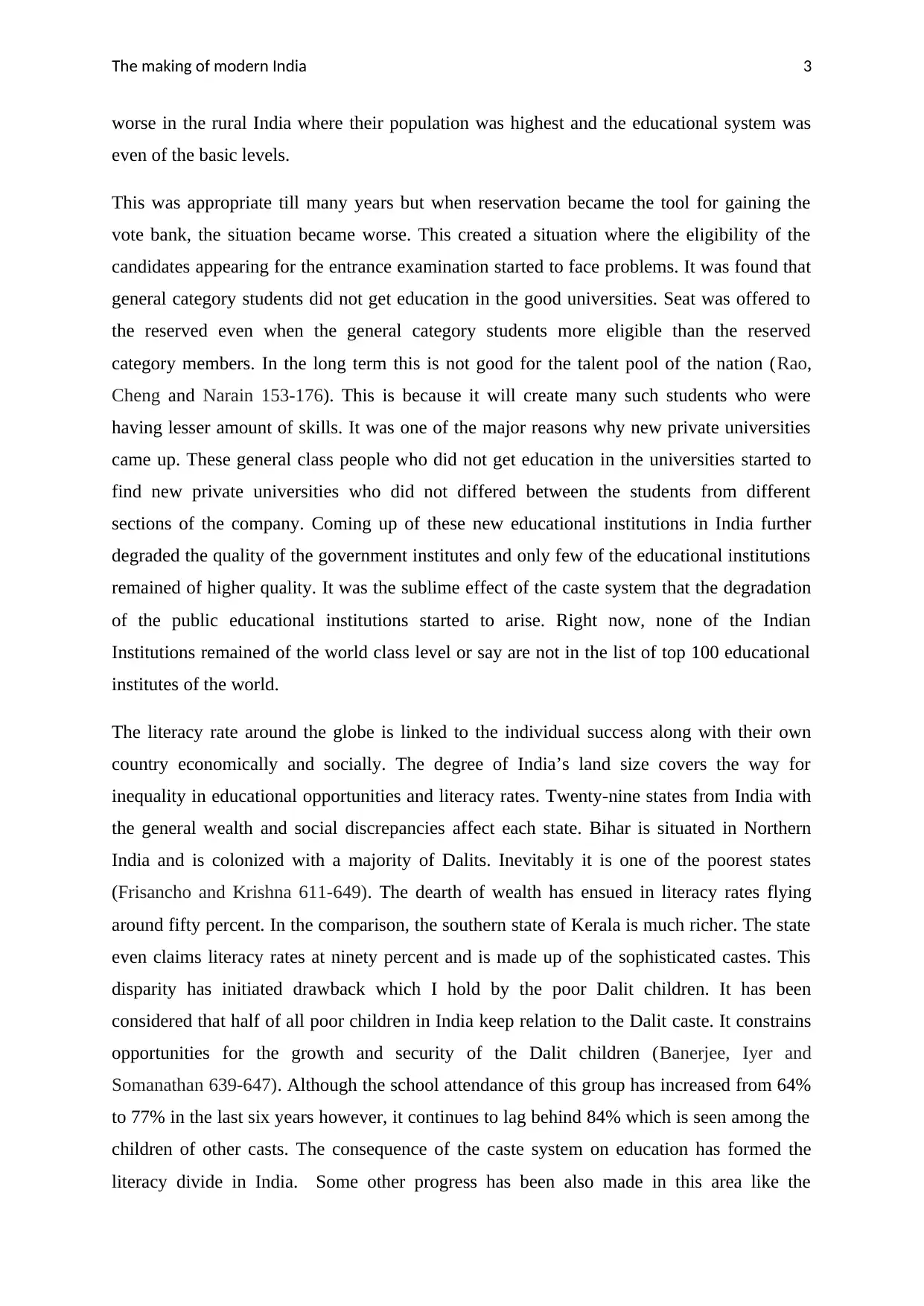
The making of modern India 3
worse in the rural India where their population was highest and the educational system was
even of the basic levels.
This was appropriate till many years but when reservation became the tool for gaining the
vote bank, the situation became worse. This created a situation where the eligibility of the
candidates appearing for the entrance examination started to face problems. It was found that
general category students did not get education in the good universities. Seat was offered to
the reserved even when the general category students more eligible than the reserved
category members. In the long term this is not good for the talent pool of the nation (Rao,
Cheng and Narain 153-176). This is because it will create many such students who were
having lesser amount of skills. It was one of the major reasons why new private universities
came up. These general class people who did not get education in the universities started to
find new private universities who did not differed between the students from different
sections of the company. Coming up of these new educational institutions in India further
degraded the quality of the government institutes and only few of the educational institutions
remained of higher quality. It was the sublime effect of the caste system that the degradation
of the public educational institutions started to arise. Right now, none of the Indian
Institutions remained of the world class level or say are not in the list of top 100 educational
institutes of the world.
The literacy rate around the globe is linked to the individual success along with their own
country economically and socially. The degree of India’s land size covers the way for
inequality in educational opportunities and literacy rates. Twenty-nine states from India with
the general wealth and social discrepancies affect each state. Bihar is situated in Northern
India and is colonized with a majority of Dalits. Inevitably it is one of the poorest states
(Frisancho and Krishna 611-649). The dearth of wealth has ensued in literacy rates flying
around fifty percent. In the comparison, the southern state of Kerala is much richer. The state
even claims literacy rates at ninety percent and is made up of the sophisticated castes. This
disparity has initiated drawback which I hold by the poor Dalit children. It has been
considered that half of all poor children in India keep relation to the Dalit caste. It constrains
opportunities for the growth and security of the Dalit children (Banerjee, Iyer and
Somanathan 639-647). Although the school attendance of this group has increased from 64%
to 77% in the last six years however, it continues to lag behind 84% which is seen among the
children of other casts. The consequence of the caste system on education has formed the
literacy divide in India. Some other progress has been also made in this area like the
worse in the rural India where their population was highest and the educational system was
even of the basic levels.
This was appropriate till many years but when reservation became the tool for gaining the
vote bank, the situation became worse. This created a situation where the eligibility of the
candidates appearing for the entrance examination started to face problems. It was found that
general category students did not get education in the good universities. Seat was offered to
the reserved even when the general category students more eligible than the reserved
category members. In the long term this is not good for the talent pool of the nation (Rao,
Cheng and Narain 153-176). This is because it will create many such students who were
having lesser amount of skills. It was one of the major reasons why new private universities
came up. These general class people who did not get education in the universities started to
find new private universities who did not differed between the students from different
sections of the company. Coming up of these new educational institutions in India further
degraded the quality of the government institutes and only few of the educational institutions
remained of higher quality. It was the sublime effect of the caste system that the degradation
of the public educational institutions started to arise. Right now, none of the Indian
Institutions remained of the world class level or say are not in the list of top 100 educational
institutes of the world.
The literacy rate around the globe is linked to the individual success along with their own
country economically and socially. The degree of India’s land size covers the way for
inequality in educational opportunities and literacy rates. Twenty-nine states from India with
the general wealth and social discrepancies affect each state. Bihar is situated in Northern
India and is colonized with a majority of Dalits. Inevitably it is one of the poorest states
(Frisancho and Krishna 611-649). The dearth of wealth has ensued in literacy rates flying
around fifty percent. In the comparison, the southern state of Kerala is much richer. The state
even claims literacy rates at ninety percent and is made up of the sophisticated castes. This
disparity has initiated drawback which I hold by the poor Dalit children. It has been
considered that half of all poor children in India keep relation to the Dalit caste. It constrains
opportunities for the growth and security of the Dalit children (Banerjee, Iyer and
Somanathan 639-647). Although the school attendance of this group has increased from 64%
to 77% in the last six years however, it continues to lag behind 84% which is seen among the
children of other casts. The consequence of the caste system on education has formed the
literacy divide in India. Some other progress has been also made in this area like the
Secure Best Marks with AI Grader
Need help grading? Try our AI Grader for instant feedback on your assignments.
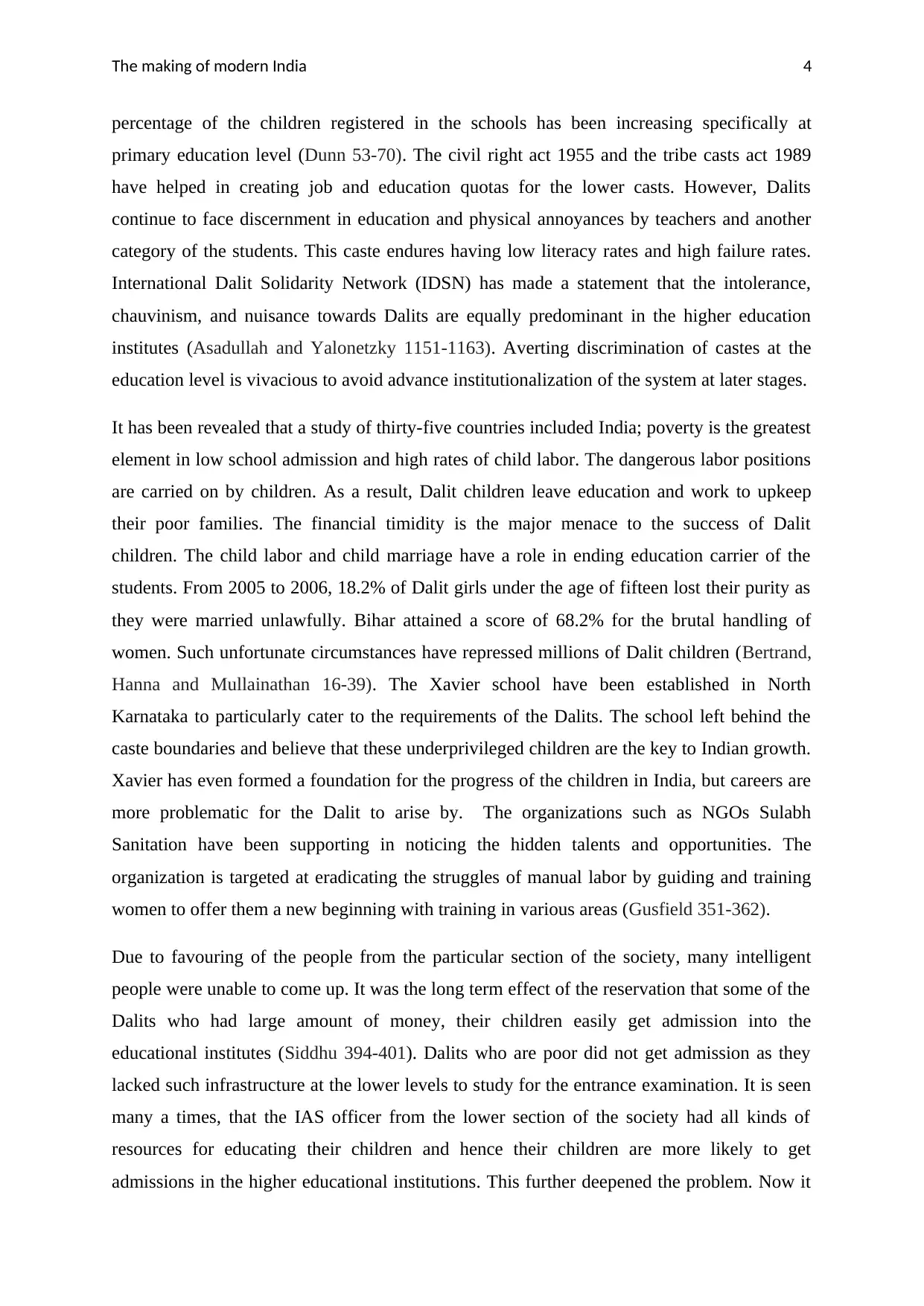
The making of modern India 4
percentage of the children registered in the schools has been increasing specifically at
primary education level (Dunn 53-70). The civil right act 1955 and the tribe casts act 1989
have helped in creating job and education quotas for the lower casts. However, Dalits
continue to face discernment in education and physical annoyances by teachers and another
category of the students. This caste endures having low literacy rates and high failure rates.
International Dalit Solidarity Network (IDSN) has made a statement that the intolerance,
chauvinism, and nuisance towards Dalits are equally predominant in the higher education
institutes (Asadullah and Yalonetzky 1151-1163). Averting discrimination of castes at the
education level is vivacious to avoid advance institutionalization of the system at later stages.
It has been revealed that a study of thirty-five countries included India; poverty is the greatest
element in low school admission and high rates of child labor. The dangerous labor positions
are carried on by children. As a result, Dalit children leave education and work to upkeep
their poor families. The financial timidity is the major menace to the success of Dalit
children. The child labor and child marriage have a role in ending education carrier of the
students. From 2005 to 2006, 18.2% of Dalit girls under the age of fifteen lost their purity as
they were married unlawfully. Bihar attained a score of 68.2% for the brutal handling of
women. Such unfortunate circumstances have repressed millions of Dalit children (Bertrand,
Hanna and Mullainathan 16-39). The Xavier school have been established in North
Karnataka to particularly cater to the requirements of the Dalits. The school left behind the
caste boundaries and believe that these underprivileged children are the key to Indian growth.
Xavier has even formed a foundation for the progress of the children in India, but careers are
more problematic for the Dalit to arise by. The organizations such as NGOs Sulabh
Sanitation have been supporting in noticing the hidden talents and opportunities. The
organization is targeted at eradicating the struggles of manual labor by guiding and training
women to offer them a new beginning with training in various areas (Gusfield 351-362).
Due to favouring of the people from the particular section of the society, many intelligent
people were unable to come up. It was the long term effect of the reservation that some of the
Dalits who had large amount of money, their children easily get admission into the
educational institutes (Siddhu 394-401). Dalits who are poor did not get admission as they
lacked such infrastructure at the lower levels to study for the entrance examination. It is seen
many a times, that the IAS officer from the lower section of the society had all kinds of
resources for educating their children and hence their children are more likely to get
admissions in the higher educational institutions. This further deepened the problem. Now it
percentage of the children registered in the schools has been increasing specifically at
primary education level (Dunn 53-70). The civil right act 1955 and the tribe casts act 1989
have helped in creating job and education quotas for the lower casts. However, Dalits
continue to face discernment in education and physical annoyances by teachers and another
category of the students. This caste endures having low literacy rates and high failure rates.
International Dalit Solidarity Network (IDSN) has made a statement that the intolerance,
chauvinism, and nuisance towards Dalits are equally predominant in the higher education
institutes (Asadullah and Yalonetzky 1151-1163). Averting discrimination of castes at the
education level is vivacious to avoid advance institutionalization of the system at later stages.
It has been revealed that a study of thirty-five countries included India; poverty is the greatest
element in low school admission and high rates of child labor. The dangerous labor positions
are carried on by children. As a result, Dalit children leave education and work to upkeep
their poor families. The financial timidity is the major menace to the success of Dalit
children. The child labor and child marriage have a role in ending education carrier of the
students. From 2005 to 2006, 18.2% of Dalit girls under the age of fifteen lost their purity as
they were married unlawfully. Bihar attained a score of 68.2% for the brutal handling of
women. Such unfortunate circumstances have repressed millions of Dalit children (Bertrand,
Hanna and Mullainathan 16-39). The Xavier school have been established in North
Karnataka to particularly cater to the requirements of the Dalits. The school left behind the
caste boundaries and believe that these underprivileged children are the key to Indian growth.
Xavier has even formed a foundation for the progress of the children in India, but careers are
more problematic for the Dalit to arise by. The organizations such as NGOs Sulabh
Sanitation have been supporting in noticing the hidden talents and opportunities. The
organization is targeted at eradicating the struggles of manual labor by guiding and training
women to offer them a new beginning with training in various areas (Gusfield 351-362).
Due to favouring of the people from the particular section of the society, many intelligent
people were unable to come up. It was the long term effect of the reservation that some of the
Dalits who had large amount of money, their children easily get admission into the
educational institutes (Siddhu 394-401). Dalits who are poor did not get admission as they
lacked such infrastructure at the lower levels to study for the entrance examination. It is seen
many a times, that the IAS officer from the lower section of the society had all kinds of
resources for educating their children and hence their children are more likely to get
admissions in the higher educational institutions. This further deepened the problem. Now it
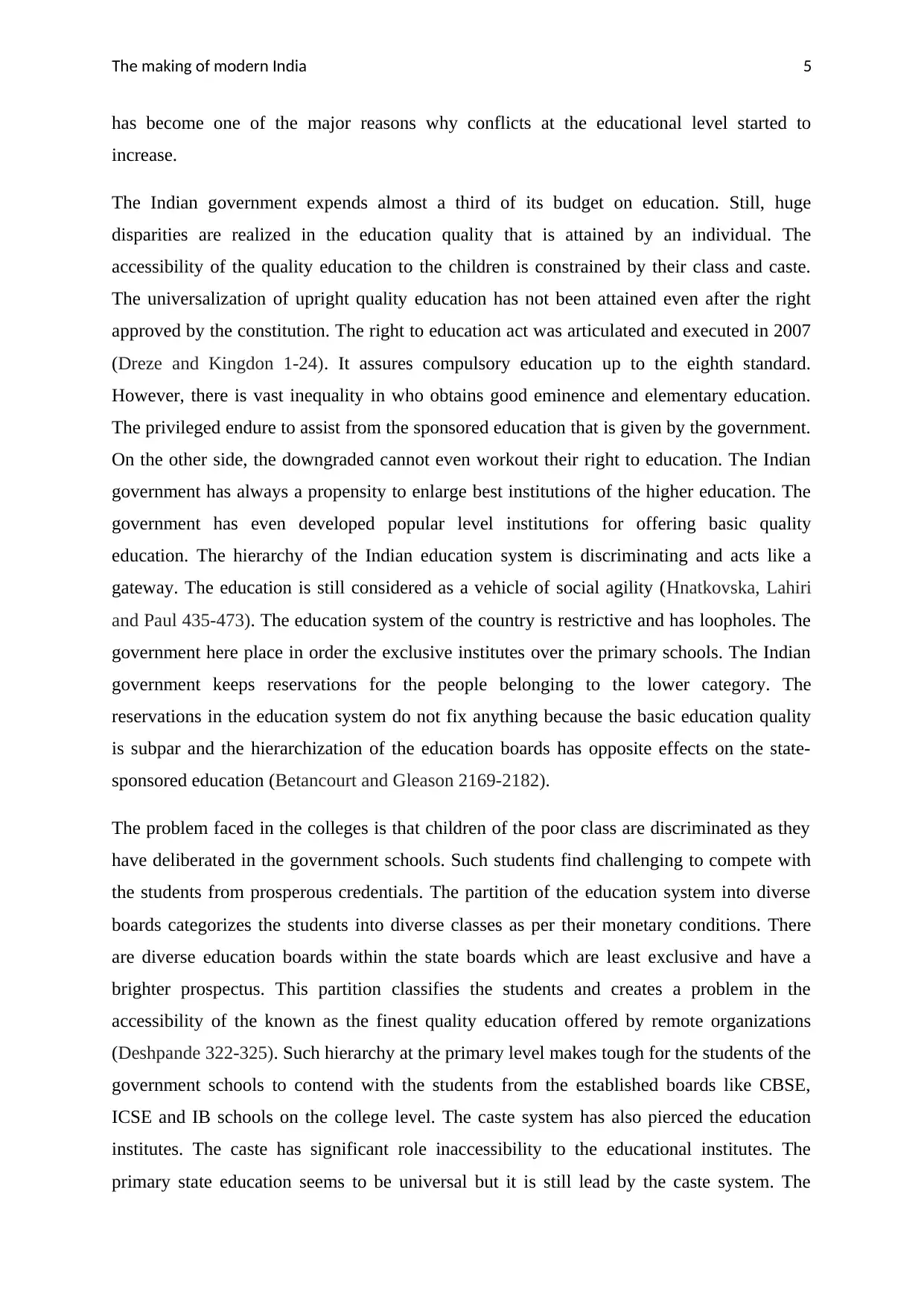
The making of modern India 5
has become one of the major reasons why conflicts at the educational level started to
increase.
The Indian government expends almost a third of its budget on education. Still, huge
disparities are realized in the education quality that is attained by an individual. The
accessibility of the quality education to the children is constrained by their class and caste.
The universalization of upright quality education has not been attained even after the right
approved by the constitution. The right to education act was articulated and executed in 2007
(Dreze and Kingdon 1-24). It assures compulsory education up to the eighth standard.
However, there is vast inequality in who obtains good eminence and elementary education.
The privileged endure to assist from the sponsored education that is given by the government.
On the other side, the downgraded cannot even workout their right to education. The Indian
government has always a propensity to enlarge best institutions of the higher education. The
government has even developed popular level institutions for offering basic quality
education. The hierarchy of the Indian education system is discriminating and acts like a
gateway. The education is still considered as a vehicle of social agility (Hnatkovska, Lahiri
and Paul 435-473). The education system of the country is restrictive and has loopholes. The
government here place in order the exclusive institutes over the primary schools. The Indian
government keeps reservations for the people belonging to the lower category. The
reservations in the education system do not fix anything because the basic education quality
is subpar and the hierarchization of the education boards has opposite effects on the state-
sponsored education (Betancourt and Gleason 2169-2182).
The problem faced in the colleges is that children of the poor class are discriminated as they
have deliberated in the government schools. Such students find challenging to compete with
the students from prosperous credentials. The partition of the education system into diverse
boards categorizes the students into diverse classes as per their monetary conditions. There
are diverse education boards within the state boards which are least exclusive and have a
brighter prospectus. This partition classifies the students and creates a problem in the
accessibility of the known as the finest quality education offered by remote organizations
(Deshpande 322-325). Such hierarchy at the primary level makes tough for the students of the
government schools to contend with the students from the established boards like CBSE,
ICSE and IB schools on the college level. The caste system has also pierced the education
institutes. The caste has significant role inaccessibility to the educational institutes. The
primary state education seems to be universal but it is still lead by the caste system. The
has become one of the major reasons why conflicts at the educational level started to
increase.
The Indian government expends almost a third of its budget on education. Still, huge
disparities are realized in the education quality that is attained by an individual. The
accessibility of the quality education to the children is constrained by their class and caste.
The universalization of upright quality education has not been attained even after the right
approved by the constitution. The right to education act was articulated and executed in 2007
(Dreze and Kingdon 1-24). It assures compulsory education up to the eighth standard.
However, there is vast inequality in who obtains good eminence and elementary education.
The privileged endure to assist from the sponsored education that is given by the government.
On the other side, the downgraded cannot even workout their right to education. The Indian
government has always a propensity to enlarge best institutions of the higher education. The
government has even developed popular level institutions for offering basic quality
education. The hierarchy of the Indian education system is discriminating and acts like a
gateway. The education is still considered as a vehicle of social agility (Hnatkovska, Lahiri
and Paul 435-473). The education system of the country is restrictive and has loopholes. The
government here place in order the exclusive institutes over the primary schools. The Indian
government keeps reservations for the people belonging to the lower category. The
reservations in the education system do not fix anything because the basic education quality
is subpar and the hierarchization of the education boards has opposite effects on the state-
sponsored education (Betancourt and Gleason 2169-2182).
The problem faced in the colleges is that children of the poor class are discriminated as they
have deliberated in the government schools. Such students find challenging to compete with
the students from prosperous credentials. The partition of the education system into diverse
boards categorizes the students into diverse classes as per their monetary conditions. There
are diverse education boards within the state boards which are least exclusive and have a
brighter prospectus. This partition classifies the students and creates a problem in the
accessibility of the known as the finest quality education offered by remote organizations
(Deshpande 322-325). Such hierarchy at the primary level makes tough for the students of the
government schools to contend with the students from the established boards like CBSE,
ICSE and IB schools on the college level. The caste system has also pierced the education
institutes. The caste has significant role inaccessibility to the educational institutes. The
primary state education seems to be universal but it is still lead by the caste system. The
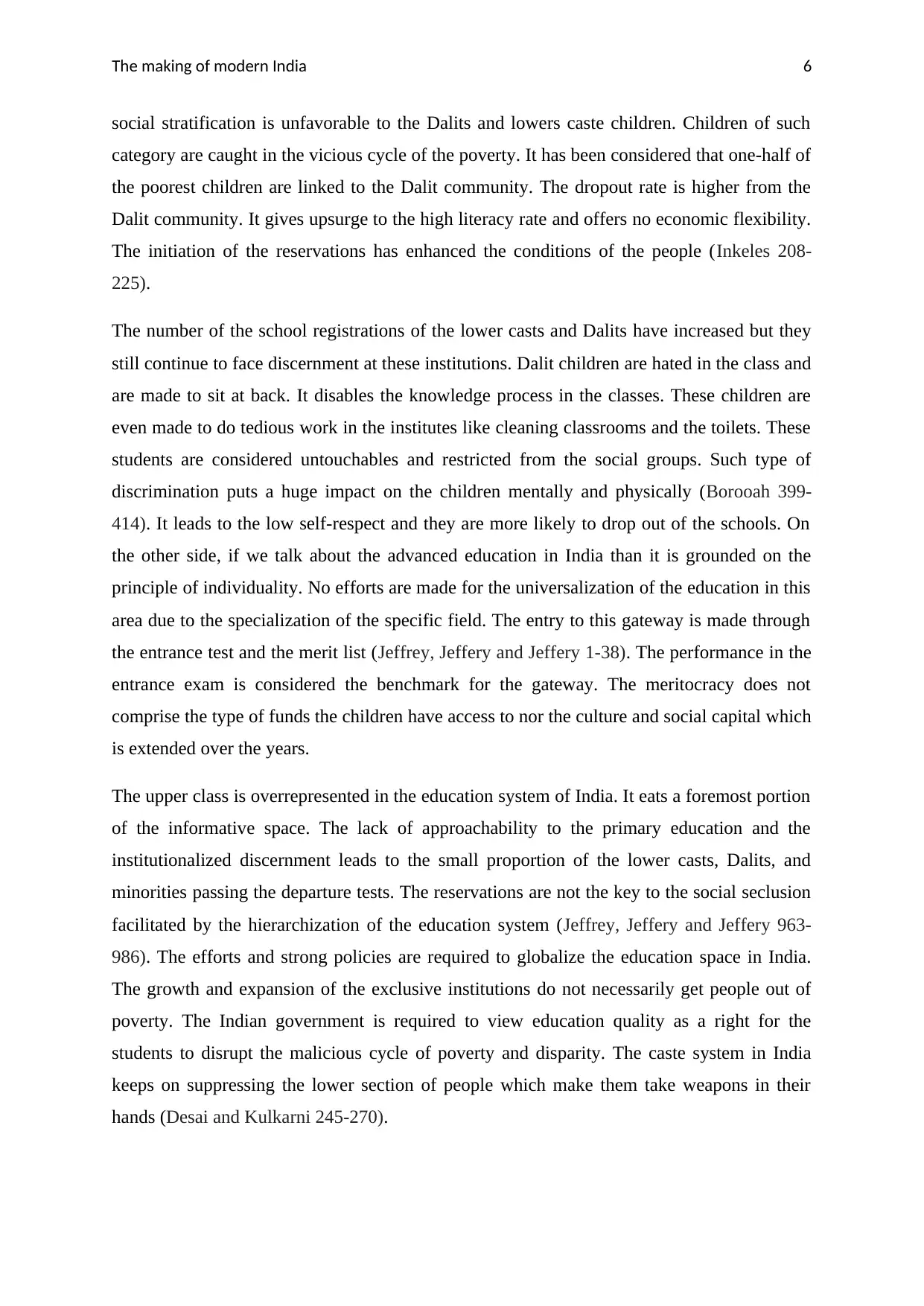
The making of modern India 6
social stratification is unfavorable to the Dalits and lowers caste children. Children of such
category are caught in the vicious cycle of the poverty. It has been considered that one-half of
the poorest children are linked to the Dalit community. The dropout rate is higher from the
Dalit community. It gives upsurge to the high literacy rate and offers no economic flexibility.
The initiation of the reservations has enhanced the conditions of the people (Inkeles 208-
225).
The number of the school registrations of the lower casts and Dalits have increased but they
still continue to face discernment at these institutions. Dalit children are hated in the class and
are made to sit at back. It disables the knowledge process in the classes. These children are
even made to do tedious work in the institutes like cleaning classrooms and the toilets. These
students are considered untouchables and restricted from the social groups. Such type of
discrimination puts a huge impact on the children mentally and physically (Borooah 399-
414). It leads to the low self-respect and they are more likely to drop out of the schools. On
the other side, if we talk about the advanced education in India than it is grounded on the
principle of individuality. No efforts are made for the universalization of the education in this
area due to the specialization of the specific field. The entry to this gateway is made through
the entrance test and the merit list (Jeffrey, Jeffery and Jeffery 1-38). The performance in the
entrance exam is considered the benchmark for the gateway. The meritocracy does not
comprise the type of funds the children have access to nor the culture and social capital which
is extended over the years.
The upper class is overrepresented in the education system of India. It eats a foremost portion
of the informative space. The lack of approachability to the primary education and the
institutionalized discernment leads to the small proportion of the lower casts, Dalits, and
minorities passing the departure tests. The reservations are not the key to the social seclusion
facilitated by the hierarchization of the education system (Jeffrey, Jeffery and Jeffery 963-
986). The efforts and strong policies are required to globalize the education space in India.
The growth and expansion of the exclusive institutions do not necessarily get people out of
poverty. The Indian government is required to view education quality as a right for the
students to disrupt the malicious cycle of poverty and disparity. The caste system in India
keeps on suppressing the lower section of people which make them take weapons in their
hands (Desai and Kulkarni 245-270).
social stratification is unfavorable to the Dalits and lowers caste children. Children of such
category are caught in the vicious cycle of the poverty. It has been considered that one-half of
the poorest children are linked to the Dalit community. The dropout rate is higher from the
Dalit community. It gives upsurge to the high literacy rate and offers no economic flexibility.
The initiation of the reservations has enhanced the conditions of the people (Inkeles 208-
225).
The number of the school registrations of the lower casts and Dalits have increased but they
still continue to face discernment at these institutions. Dalit children are hated in the class and
are made to sit at back. It disables the knowledge process in the classes. These children are
even made to do tedious work in the institutes like cleaning classrooms and the toilets. These
students are considered untouchables and restricted from the social groups. Such type of
discrimination puts a huge impact on the children mentally and physically (Borooah 399-
414). It leads to the low self-respect and they are more likely to drop out of the schools. On
the other side, if we talk about the advanced education in India than it is grounded on the
principle of individuality. No efforts are made for the universalization of the education in this
area due to the specialization of the specific field. The entry to this gateway is made through
the entrance test and the merit list (Jeffrey, Jeffery and Jeffery 1-38). The performance in the
entrance exam is considered the benchmark for the gateway. The meritocracy does not
comprise the type of funds the children have access to nor the culture and social capital which
is extended over the years.
The upper class is overrepresented in the education system of India. It eats a foremost portion
of the informative space. The lack of approachability to the primary education and the
institutionalized discernment leads to the small proportion of the lower casts, Dalits, and
minorities passing the departure tests. The reservations are not the key to the social seclusion
facilitated by the hierarchization of the education system (Jeffrey, Jeffery and Jeffery 963-
986). The efforts and strong policies are required to globalize the education space in India.
The growth and expansion of the exclusive institutions do not necessarily get people out of
poverty. The Indian government is required to view education quality as a right for the
students to disrupt the malicious cycle of poverty and disparity. The caste system in India
keeps on suppressing the lower section of people which make them take weapons in their
hands (Desai and Kulkarni 245-270).
Paraphrase This Document
Need a fresh take? Get an instant paraphrase of this document with our AI Paraphraser
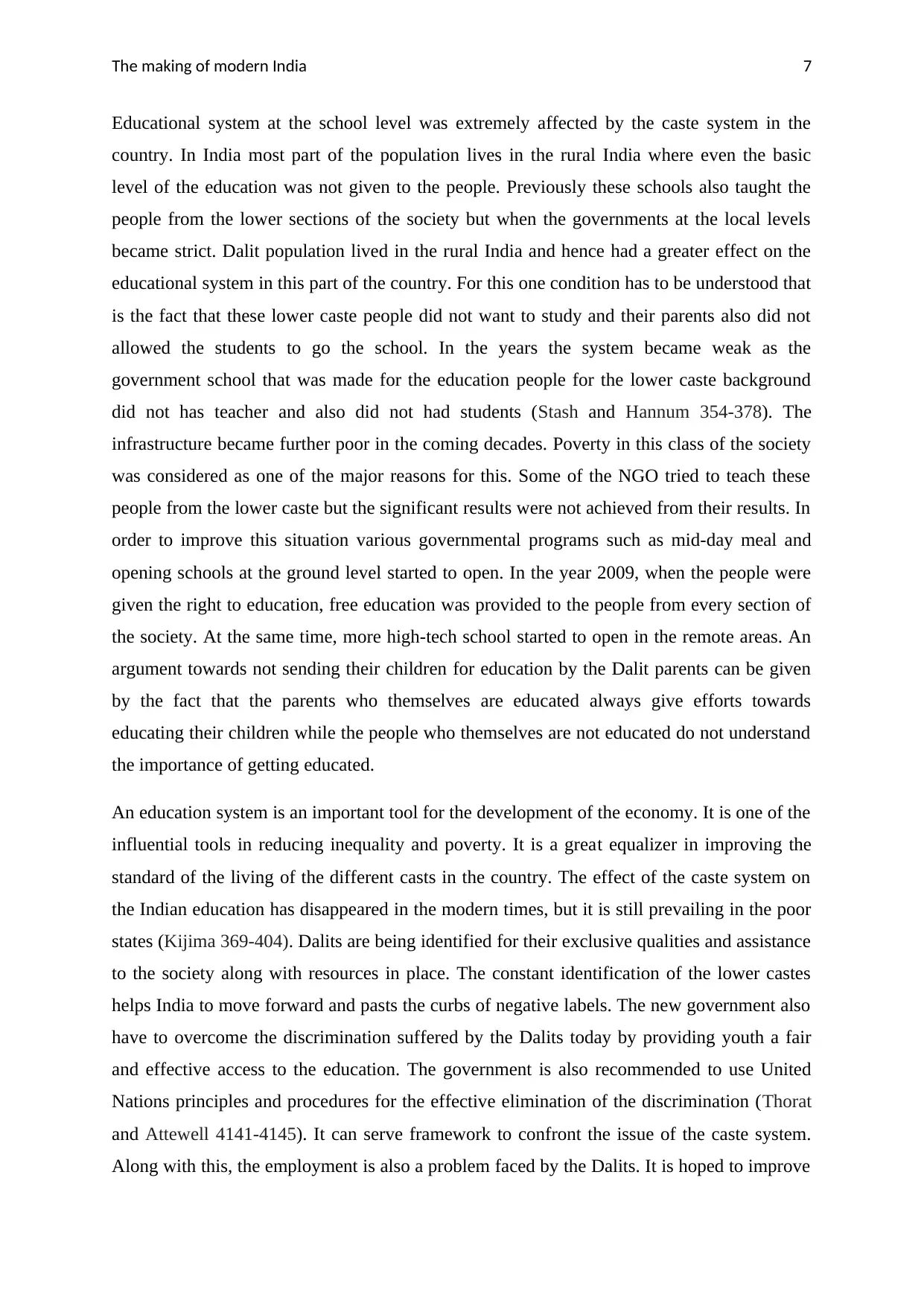
The making of modern India 7
Educational system at the school level was extremely affected by the caste system in the
country. In India most part of the population lives in the rural India where even the basic
level of the education was not given to the people. Previously these schools also taught the
people from the lower sections of the society but when the governments at the local levels
became strict. Dalit population lived in the rural India and hence had a greater effect on the
educational system in this part of the country. For this one condition has to be understood that
is the fact that these lower caste people did not want to study and their parents also did not
allowed the students to go the school. In the years the system became weak as the
government school that was made for the education people for the lower caste background
did not has teacher and also did not had students (Stash and Hannum 354-378). The
infrastructure became further poor in the coming decades. Poverty in this class of the society
was considered as one of the major reasons for this. Some of the NGO tried to teach these
people from the lower caste but the significant results were not achieved from their results. In
order to improve this situation various governmental programs such as mid-day meal and
opening schools at the ground level started to open. In the year 2009, when the people were
given the right to education, free education was provided to the people from every section of
the society. At the same time, more high-tech school started to open in the remote areas. An
argument towards not sending their children for education by the Dalit parents can be given
by the fact that the parents who themselves are educated always give efforts towards
educating their children while the people who themselves are not educated do not understand
the importance of getting educated.
An education system is an important tool for the development of the economy. It is one of the
influential tools in reducing inequality and poverty. It is a great equalizer in improving the
standard of the living of the different casts in the country. The effect of the caste system on
the Indian education has disappeared in the modern times, but it is still prevailing in the poor
states (Kijima 369-404). Dalits are being identified for their exclusive qualities and assistance
to the society along with resources in place. The constant identification of the lower castes
helps India to move forward and pasts the curbs of negative labels. The new government also
have to overcome the discrimination suffered by the Dalits today by providing youth a fair
and effective access to the education. The government is also recommended to use United
Nations principles and procedures for the effective elimination of the discrimination (Thorat
and Attewell 4141-4145). It can serve framework to confront the issue of the caste system.
Along with this, the employment is also a problem faced by the Dalits. It is hoped to improve
Educational system at the school level was extremely affected by the caste system in the
country. In India most part of the population lives in the rural India where even the basic
level of the education was not given to the people. Previously these schools also taught the
people from the lower sections of the society but when the governments at the local levels
became strict. Dalit population lived in the rural India and hence had a greater effect on the
educational system in this part of the country. For this one condition has to be understood that
is the fact that these lower caste people did not want to study and their parents also did not
allowed the students to go the school. In the years the system became weak as the
government school that was made for the education people for the lower caste background
did not has teacher and also did not had students (Stash and Hannum 354-378). The
infrastructure became further poor in the coming decades. Poverty in this class of the society
was considered as one of the major reasons for this. Some of the NGO tried to teach these
people from the lower caste but the significant results were not achieved from their results. In
order to improve this situation various governmental programs such as mid-day meal and
opening schools at the ground level started to open. In the year 2009, when the people were
given the right to education, free education was provided to the people from every section of
the society. At the same time, more high-tech school started to open in the remote areas. An
argument towards not sending their children for education by the Dalit parents can be given
by the fact that the parents who themselves are educated always give efforts towards
educating their children while the people who themselves are not educated do not understand
the importance of getting educated.
An education system is an important tool for the development of the economy. It is one of the
influential tools in reducing inequality and poverty. It is a great equalizer in improving the
standard of the living of the different casts in the country. The effect of the caste system on
the Indian education has disappeared in the modern times, but it is still prevailing in the poor
states (Kijima 369-404). Dalits are being identified for their exclusive qualities and assistance
to the society along with resources in place. The constant identification of the lower castes
helps India to move forward and pasts the curbs of negative labels. The new government also
have to overcome the discrimination suffered by the Dalits today by providing youth a fair
and effective access to the education. The government is also recommended to use United
Nations principles and procedures for the effective elimination of the discrimination (Thorat
and Attewell 4141-4145). It can serve framework to confront the issue of the caste system.
Along with this, the employment is also a problem faced by the Dalits. It is hoped to improve
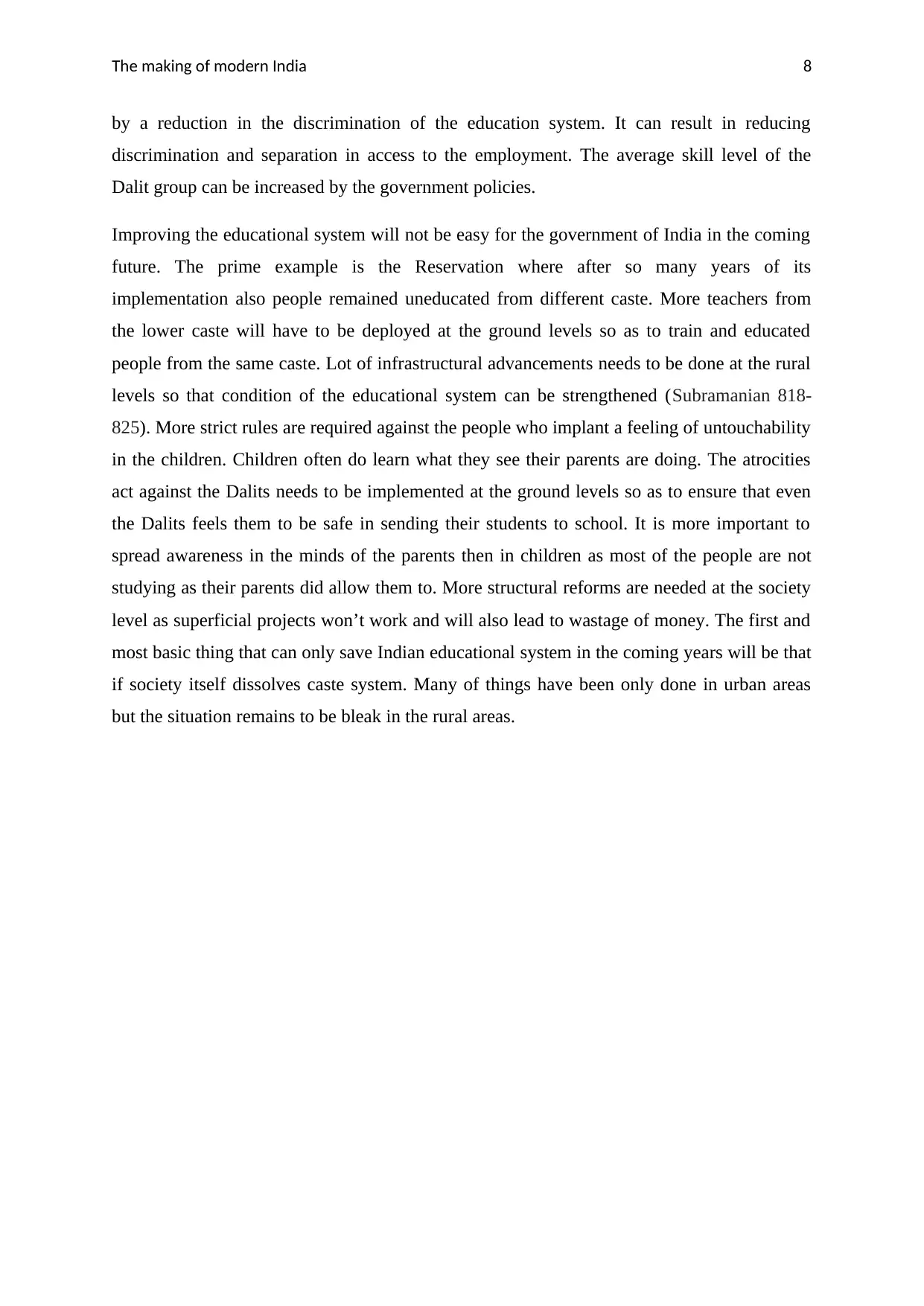
The making of modern India 8
by a reduction in the discrimination of the education system. It can result in reducing
discrimination and separation in access to the employment. The average skill level of the
Dalit group can be increased by the government policies.
Improving the educational system will not be easy for the government of India in the coming
future. The prime example is the Reservation where after so many years of its
implementation also people remained uneducated from different caste. More teachers from
the lower caste will have to be deployed at the ground levels so as to train and educated
people from the same caste. Lot of infrastructural advancements needs to be done at the rural
levels so that condition of the educational system can be strengthened (Subramanian 818-
825). More strict rules are required against the people who implant a feeling of untouchability
in the children. Children often do learn what they see their parents are doing. The atrocities
act against the Dalits needs to be implemented at the ground levels so as to ensure that even
the Dalits feels them to be safe in sending their students to school. It is more important to
spread awareness in the minds of the parents then in children as most of the people are not
studying as their parents did allow them to. More structural reforms are needed at the society
level as superficial projects won’t work and will also lead to wastage of money. The first and
most basic thing that can only save Indian educational system in the coming years will be that
if society itself dissolves caste system. Many of things have been only done in urban areas
but the situation remains to be bleak in the rural areas.
by a reduction in the discrimination of the education system. It can result in reducing
discrimination and separation in access to the employment. The average skill level of the
Dalit group can be increased by the government policies.
Improving the educational system will not be easy for the government of India in the coming
future. The prime example is the Reservation where after so many years of its
implementation also people remained uneducated from different caste. More teachers from
the lower caste will have to be deployed at the ground levels so as to train and educated
people from the same caste. Lot of infrastructural advancements needs to be done at the rural
levels so that condition of the educational system can be strengthened (Subramanian 818-
825). More strict rules are required against the people who implant a feeling of untouchability
in the children. Children often do learn what they see their parents are doing. The atrocities
act against the Dalits needs to be implemented at the ground levels so as to ensure that even
the Dalits feels them to be safe in sending their students to school. It is more important to
spread awareness in the minds of the parents then in children as most of the people are not
studying as their parents did allow them to. More structural reforms are needed at the society
level as superficial projects won’t work and will also lead to wastage of money. The first and
most basic thing that can only save Indian educational system in the coming years will be that
if society itself dissolves caste system. Many of things have been only done in urban areas
but the situation remains to be bleak in the rural areas.
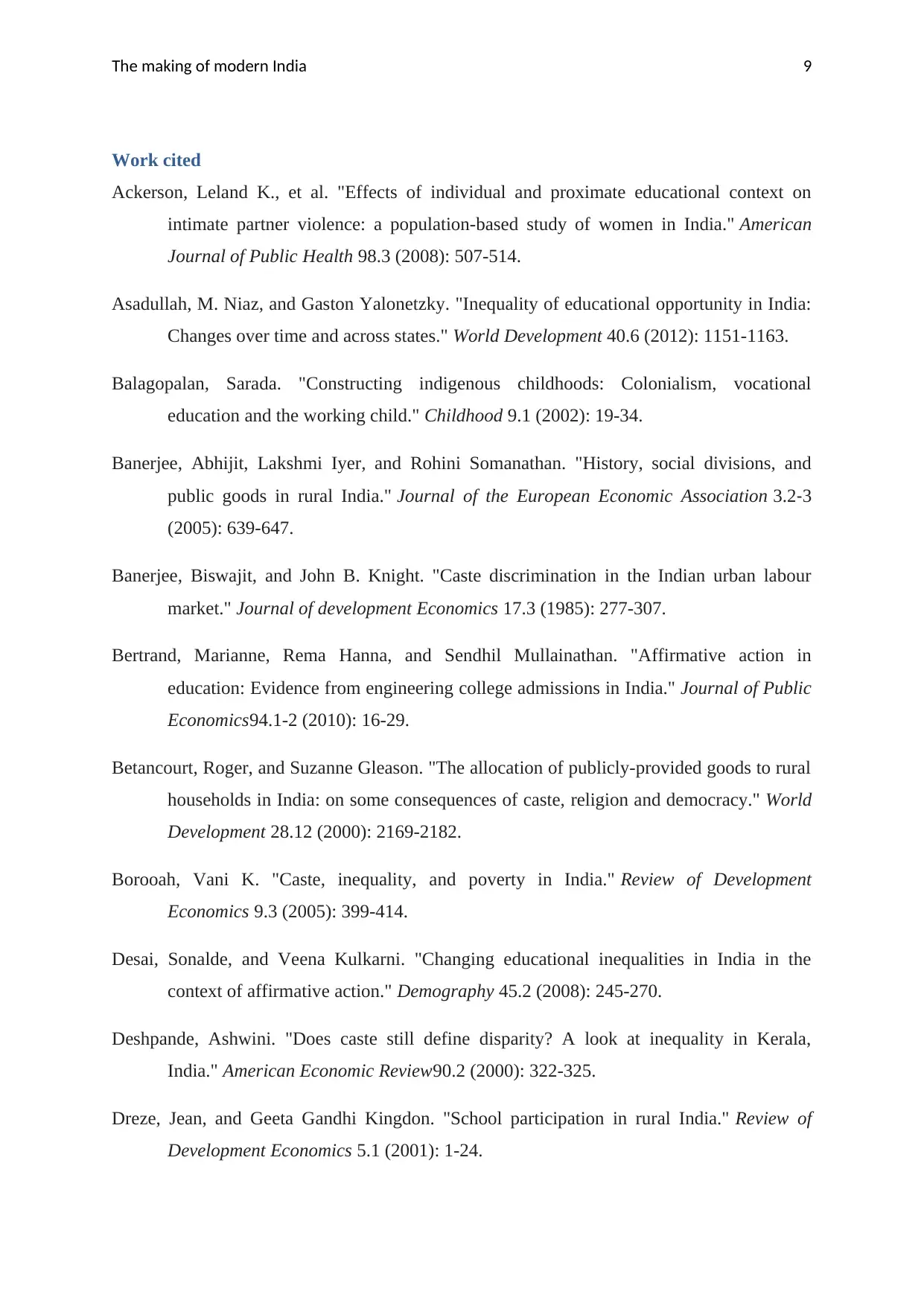
The making of modern India 9
Work cited
Ackerson, Leland K., et al. "Effects of individual and proximate educational context on
intimate partner violence: a population-based study of women in India." American
Journal of Public Health 98.3 (2008): 507-514.
Asadullah, M. Niaz, and Gaston Yalonetzky. "Inequality of educational opportunity in India:
Changes over time and across states." World Development 40.6 (2012): 1151-1163.
Balagopalan, Sarada. "Constructing indigenous childhoods: Colonialism, vocational
education and the working child." Childhood 9.1 (2002): 19-34.
Banerjee, Abhijit, Lakshmi Iyer, and Rohini Somanathan. "History, social divisions, and
public goods in rural India." Journal of the European Economic Association 3.2‐3
(2005): 639-647.
Banerjee, Biswajit, and John B. Knight. "Caste discrimination in the Indian urban labour
market." Journal of development Economics 17.3 (1985): 277-307.
Bertrand, Marianne, Rema Hanna, and Sendhil Mullainathan. "Affirmative action in
education: Evidence from engineering college admissions in India." Journal of Public
Economics94.1-2 (2010): 16-29.
Betancourt, Roger, and Suzanne Gleason. "The allocation of publicly-provided goods to rural
households in India: on some consequences of caste, religion and democracy." World
Development 28.12 (2000): 2169-2182.
Borooah, Vani K. "Caste, inequality, and poverty in India." Review of Development
Economics 9.3 (2005): 399-414.
Desai, Sonalde, and Veena Kulkarni. "Changing educational inequalities in India in the
context of affirmative action." Demography 45.2 (2008): 245-270.
Deshpande, Ashwini. "Does caste still define disparity? A look at inequality in Kerala,
India." American Economic Review90.2 (2000): 322-325.
Dreze, Jean, and Geeta Gandhi Kingdon. "School participation in rural India." Review of
Development Economics 5.1 (2001): 1-24.
Work cited
Ackerson, Leland K., et al. "Effects of individual and proximate educational context on
intimate partner violence: a population-based study of women in India." American
Journal of Public Health 98.3 (2008): 507-514.
Asadullah, M. Niaz, and Gaston Yalonetzky. "Inequality of educational opportunity in India:
Changes over time and across states." World Development 40.6 (2012): 1151-1163.
Balagopalan, Sarada. "Constructing indigenous childhoods: Colonialism, vocational
education and the working child." Childhood 9.1 (2002): 19-34.
Banerjee, Abhijit, Lakshmi Iyer, and Rohini Somanathan. "History, social divisions, and
public goods in rural India." Journal of the European Economic Association 3.2‐3
(2005): 639-647.
Banerjee, Biswajit, and John B. Knight. "Caste discrimination in the Indian urban labour
market." Journal of development Economics 17.3 (1985): 277-307.
Bertrand, Marianne, Rema Hanna, and Sendhil Mullainathan. "Affirmative action in
education: Evidence from engineering college admissions in India." Journal of Public
Economics94.1-2 (2010): 16-29.
Betancourt, Roger, and Suzanne Gleason. "The allocation of publicly-provided goods to rural
households in India: on some consequences of caste, religion and democracy." World
Development 28.12 (2000): 2169-2182.
Borooah, Vani K. "Caste, inequality, and poverty in India." Review of Development
Economics 9.3 (2005): 399-414.
Desai, Sonalde, and Veena Kulkarni. "Changing educational inequalities in India in the
context of affirmative action." Demography 45.2 (2008): 245-270.
Deshpande, Ashwini. "Does caste still define disparity? A look at inequality in Kerala,
India." American Economic Review90.2 (2000): 322-325.
Dreze, Jean, and Geeta Gandhi Kingdon. "School participation in rural India." Review of
Development Economics 5.1 (2001): 1-24.
Secure Best Marks with AI Grader
Need help grading? Try our AI Grader for instant feedback on your assignments.
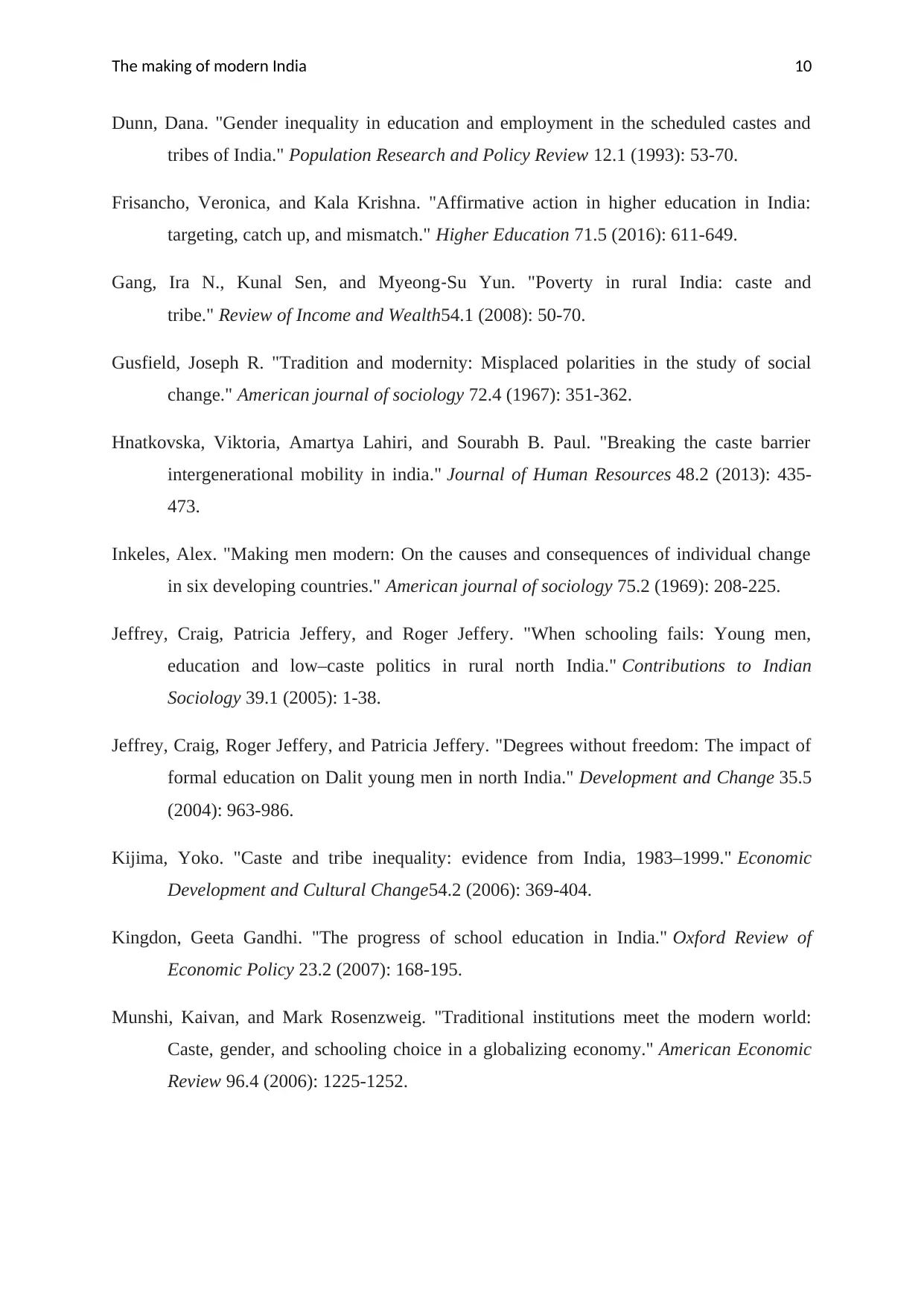
The making of modern India 10
Dunn, Dana. "Gender inequality in education and employment in the scheduled castes and
tribes of India." Population Research and Policy Review 12.1 (1993): 53-70.
Frisancho, Veronica, and Kala Krishna. "Affirmative action in higher education in India:
targeting, catch up, and mismatch." Higher Education 71.5 (2016): 611-649.
Gang, Ira N., Kunal Sen, and Myeong‐Su Yun. "Poverty in rural India: caste and
tribe." Review of Income and Wealth54.1 (2008): 50-70.
Gusfield, Joseph R. "Tradition and modernity: Misplaced polarities in the study of social
change." American journal of sociology 72.4 (1967): 351-362.
Hnatkovska, Viktoria, Amartya Lahiri, and Sourabh B. Paul. "Breaking the caste barrier
intergenerational mobility in india." Journal of Human Resources 48.2 (2013): 435-
473.
Inkeles, Alex. "Making men modern: On the causes and consequences of individual change
in six developing countries." American journal of sociology 75.2 (1969): 208-225.
Jeffrey, Craig, Patricia Jeffery, and Roger Jeffery. "When schooling fails: Young men,
education and low–caste politics in rural north India." Contributions to Indian
Sociology 39.1 (2005): 1-38.
Jeffrey, Craig, Roger Jeffery, and Patricia Jeffery. "Degrees without freedom: The impact of
formal education on Dalit young men in north India." Development and Change 35.5
(2004): 963-986.
Kijima, Yoko. "Caste and tribe inequality: evidence from India, 1983–1999." Economic
Development and Cultural Change54.2 (2006): 369-404.
Kingdon, Geeta Gandhi. "The progress of school education in India." Oxford Review of
Economic Policy 23.2 (2007): 168-195.
Munshi, Kaivan, and Mark Rosenzweig. "Traditional institutions meet the modern world:
Caste, gender, and schooling choice in a globalizing economy." American Economic
Review 96.4 (2006): 1225-1252.
Dunn, Dana. "Gender inequality in education and employment in the scheduled castes and
tribes of India." Population Research and Policy Review 12.1 (1993): 53-70.
Frisancho, Veronica, and Kala Krishna. "Affirmative action in higher education in India:
targeting, catch up, and mismatch." Higher Education 71.5 (2016): 611-649.
Gang, Ira N., Kunal Sen, and Myeong‐Su Yun. "Poverty in rural India: caste and
tribe." Review of Income and Wealth54.1 (2008): 50-70.
Gusfield, Joseph R. "Tradition and modernity: Misplaced polarities in the study of social
change." American journal of sociology 72.4 (1967): 351-362.
Hnatkovska, Viktoria, Amartya Lahiri, and Sourabh B. Paul. "Breaking the caste barrier
intergenerational mobility in india." Journal of Human Resources 48.2 (2013): 435-
473.
Inkeles, Alex. "Making men modern: On the causes and consequences of individual change
in six developing countries." American journal of sociology 75.2 (1969): 208-225.
Jeffrey, Craig, Patricia Jeffery, and Roger Jeffery. "When schooling fails: Young men,
education and low–caste politics in rural north India." Contributions to Indian
Sociology 39.1 (2005): 1-38.
Jeffrey, Craig, Roger Jeffery, and Patricia Jeffery. "Degrees without freedom: The impact of
formal education on Dalit young men in north India." Development and Change 35.5
(2004): 963-986.
Kijima, Yoko. "Caste and tribe inequality: evidence from India, 1983–1999." Economic
Development and Cultural Change54.2 (2006): 369-404.
Kingdon, Geeta Gandhi. "The progress of school education in India." Oxford Review of
Economic Policy 23.2 (2007): 168-195.
Munshi, Kaivan, and Mark Rosenzweig. "Traditional institutions meet the modern world:
Caste, gender, and schooling choice in a globalizing economy." American Economic
Review 96.4 (2006): 1225-1252.
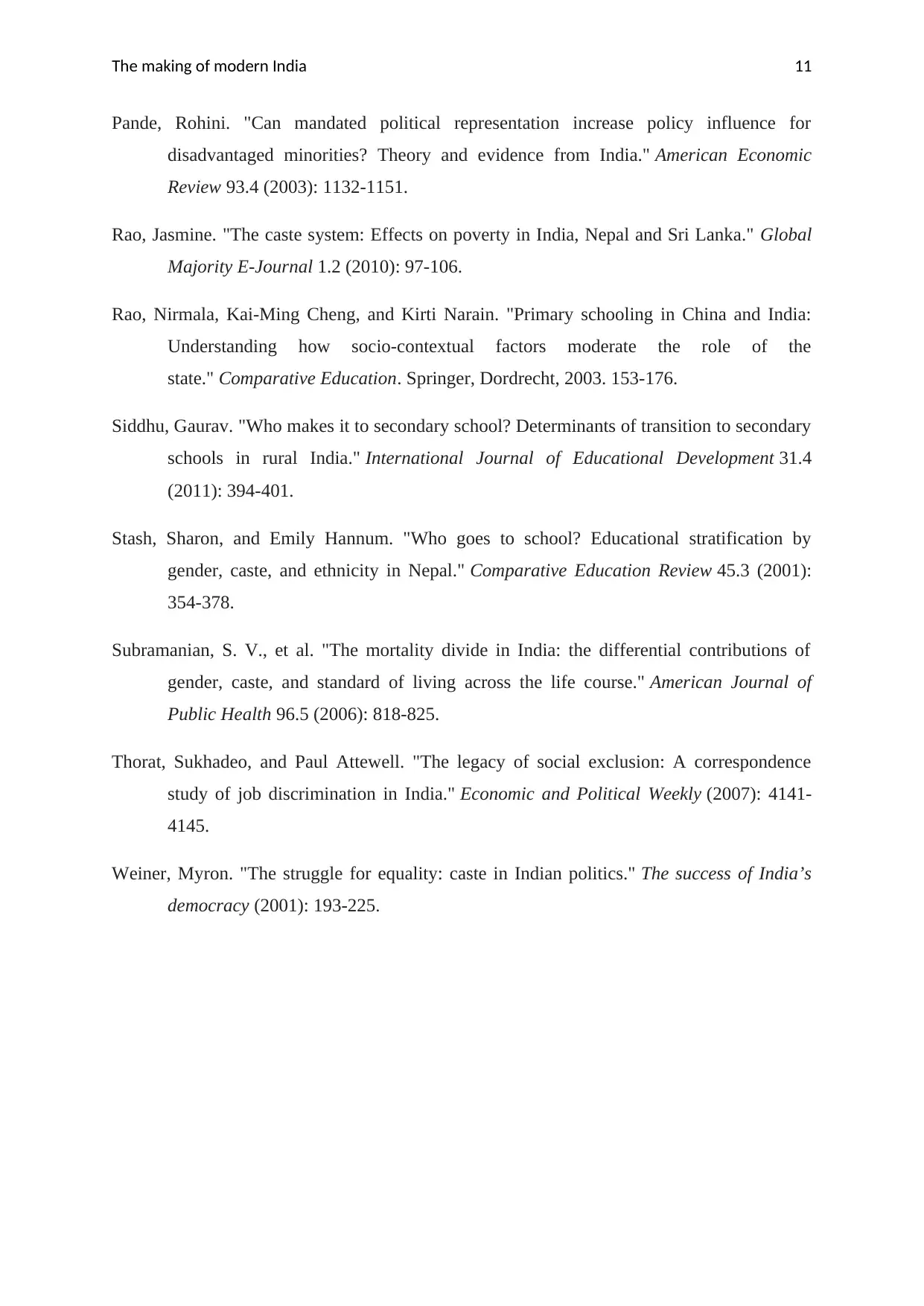
The making of modern India 11
Pande, Rohini. "Can mandated political representation increase policy influence for
disadvantaged minorities? Theory and evidence from India." American Economic
Review 93.4 (2003): 1132-1151.
Rao, Jasmine. "The caste system: Effects on poverty in India, Nepal and Sri Lanka." Global
Majority E-Journal 1.2 (2010): 97-106.
Rao, Nirmala, Kai-Ming Cheng, and Kirti Narain. "Primary schooling in China and India:
Understanding how socio-contextual factors moderate the role of the
state." Comparative Education. Springer, Dordrecht, 2003. 153-176.
Siddhu, Gaurav. "Who makes it to secondary school? Determinants of transition to secondary
schools in rural India." International Journal of Educational Development 31.4
(2011): 394-401.
Stash, Sharon, and Emily Hannum. "Who goes to school? Educational stratification by
gender, caste, and ethnicity in Nepal." Comparative Education Review 45.3 (2001):
354-378.
Subramanian, S. V., et al. "The mortality divide in India: the differential contributions of
gender, caste, and standard of living across the life course." American Journal of
Public Health 96.5 (2006): 818-825.
Thorat, Sukhadeo, and Paul Attewell. "The legacy of social exclusion: A correspondence
study of job discrimination in India." Economic and Political Weekly (2007): 4141-
4145.
Weiner, Myron. "The struggle for equality: caste in Indian politics." The success of India’s
democracy (2001): 193-225.
Pande, Rohini. "Can mandated political representation increase policy influence for
disadvantaged minorities? Theory and evidence from India." American Economic
Review 93.4 (2003): 1132-1151.
Rao, Jasmine. "The caste system: Effects on poverty in India, Nepal and Sri Lanka." Global
Majority E-Journal 1.2 (2010): 97-106.
Rao, Nirmala, Kai-Ming Cheng, and Kirti Narain. "Primary schooling in China and India:
Understanding how socio-contextual factors moderate the role of the
state." Comparative Education. Springer, Dordrecht, 2003. 153-176.
Siddhu, Gaurav. "Who makes it to secondary school? Determinants of transition to secondary
schools in rural India." International Journal of Educational Development 31.4
(2011): 394-401.
Stash, Sharon, and Emily Hannum. "Who goes to school? Educational stratification by
gender, caste, and ethnicity in Nepal." Comparative Education Review 45.3 (2001):
354-378.
Subramanian, S. V., et al. "The mortality divide in India: the differential contributions of
gender, caste, and standard of living across the life course." American Journal of
Public Health 96.5 (2006): 818-825.
Thorat, Sukhadeo, and Paul Attewell. "The legacy of social exclusion: A correspondence
study of job discrimination in India." Economic and Political Weekly (2007): 4141-
4145.
Weiner, Myron. "The struggle for equality: caste in Indian politics." The success of India’s
democracy (2001): 193-225.
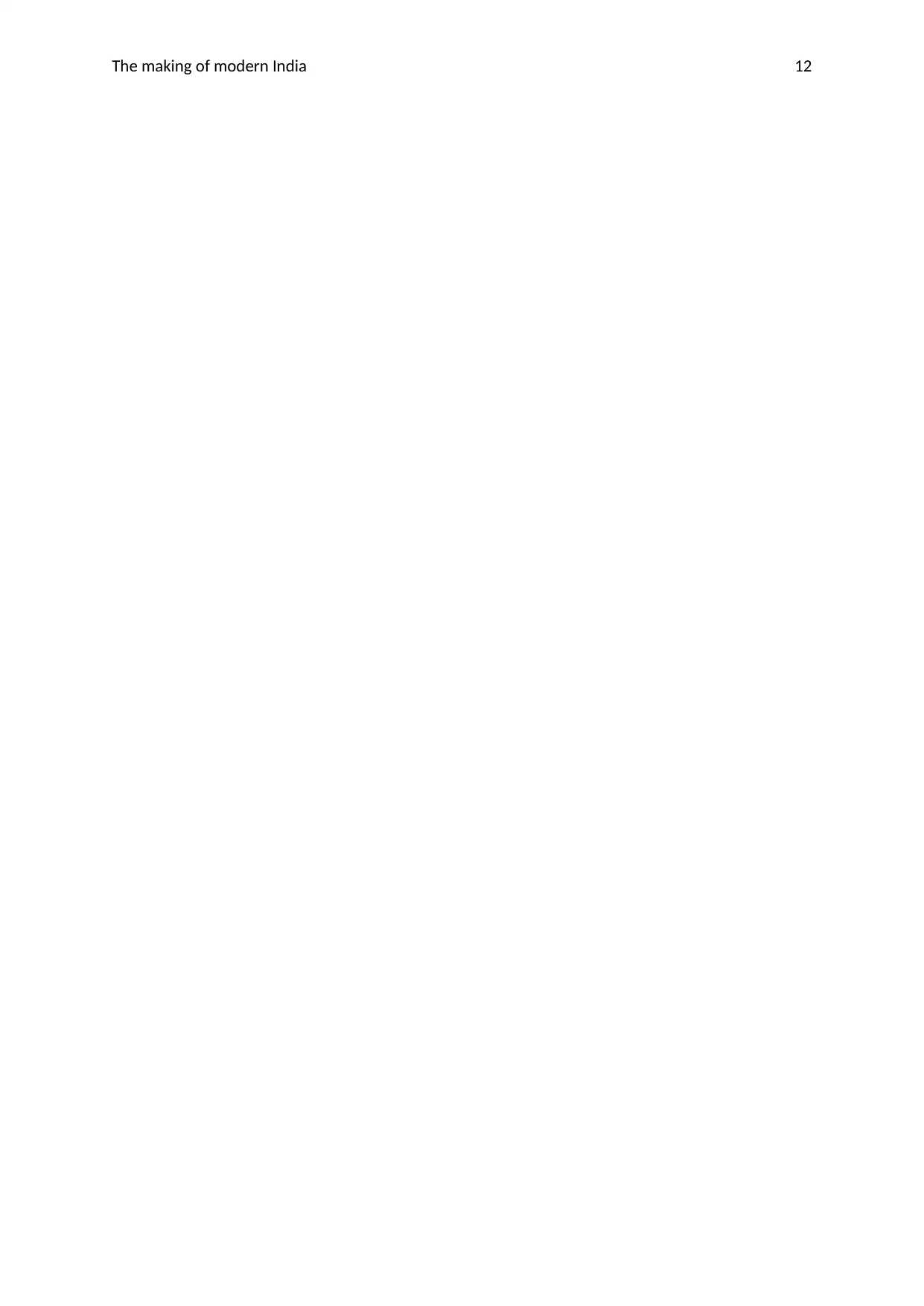
The making of modern India 12
1 out of 13
Your All-in-One AI-Powered Toolkit for Academic Success.
+13062052269
info@desklib.com
Available 24*7 on WhatsApp / Email
![[object Object]](/_next/static/media/star-bottom.7253800d.svg)
Unlock your academic potential
© 2024 | Zucol Services PVT LTD | All rights reserved.

